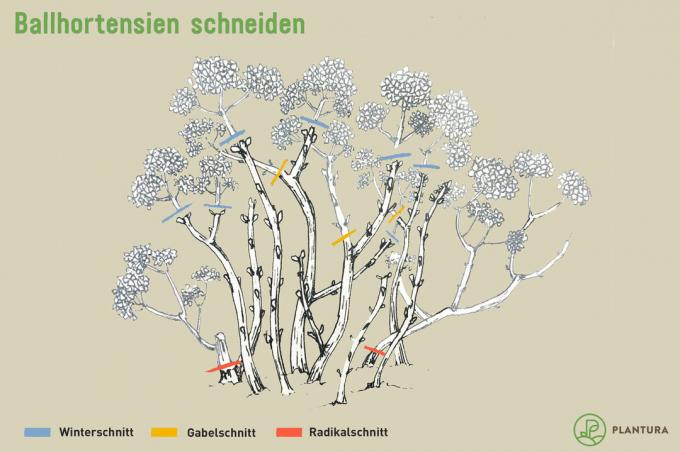Everything you need to know about hydrangea pruning: the best time to prune and how-tos for different types of hydrangeas.

The right cut is essential for magnificent hydrangea flowers. However, the different ones are different Hydrangea species in which cut is the right one at which point in time. While some species - such as Panicle hydrangeas (Hydrangea paniculata) or snowball hydrangeas (Hydrangea arborescens) can easily showcase their abundance of flowers year after year, with the classic and widespread Farm hydrangeas (Hydrangea macrophylla) fail to bloom in a year. This can often be prevented, especially with the right cut.
contents
-
Cutting hydrangeas: the right time
- Cut hydrangeas in autumn
- Cut hydrangeas in spring
-
Instructions: Cut different types of hydrangea correctly
- Cut farm hydrangeas correctly
- Cut snowball and panicle hydrangeas properly
- Trimming climbing hydrangeas properly
For the correct pruning of
Hydrangeas (Hydrangea) you first have to know which species have taken root in your home garden. Because farm hydrangeas (Hydrangea macrophylla) and Oak leaf hydrangeas (Hydrangea quercifolia) develop their flower systems for the next year in autumn. So they bloom on last year's wood. If you cut back too much here, this can mean the loss of the beautiful flower. Panicle (Hydrangea paniculata) or snowball hydrangeas (Hydrangea arborescens), on the other hand, bloom on so-called annual wood - that is, they form their flowers in the same year in which they bloom. These two popular hydrangeas are among the species that can be pruned back without being disturbed.Cutting hydrangeas: the right time
Hydrangeas can be pruned either in autumn or in spring before they sprout. Both times have their advantages and disadvantages.
Cut hydrangeas in autumn
If you cut your hydrangeas in autumn, you should consider the following points:
- Dried up flowers no longer serve as a breeding ground for fungal pathogens
- If the hydrangea is not adequately protected from frost, it can penetrate more easily through the interfaces and cause damage

Cut hydrangeas in spring
The following advantages and disadvantages arise if hydrangeas are cut in spring instead of in autumn:
- Even dried flowers still have a certain ornamental value in winter
- It is not so easy for the frost to damage the hydrangea
- If the hydrangea is wrapped to protect it from frost, mold can develop more quickly on the dried up plant remains due to poor air circulation
Instructions: Cut different types of hydrangea correctly
When it comes to pruning, the type of hydrangea is particularly important. We are mainly looking at the classic farmer's hydrangea that bloomed on the wood of the previous year and the snowball and panicle hydrangeas, which can also bloom on the new shoot. You will also learn what to consider when pruning climbing hydrangeas.
Cut farm hydrangeas correctly
With the classic Farm hydrangea Radical pruning should be avoided if possible. Most of the varieties will not bloom in the next year. It is better to correct the shape by pruning some shoots every year. With some new varieties of the Hydrangea macrophylla this is now obsolete because they are remontant - this means that they can bloom several times a year and also on the fresh shoot.
- Cut flowers in autumn: Dried flowers should ideally be cut back in autumn, but they can also be cut back in spring. It is important to make the cut just below the inflorescence so as not to endanger the flowering in the following year.
- Cut out weak and dead branches: Together with cutting off the inflorescences, sick and weak shoots can also be cut out. This lowers the risk of infection with fungal pathogens and creates some light inside the woody bush.
- Remove old shoots: Older shoots that are already very well branched and have very strong branches at the base should be removed at times. Depending on the size and age of the hydrangea, more or fewer shoots can be cut a few centimeters above the ground. This gives the plant more energy for the new shoot and larger flowers on the younger, more vital branches.
- Avoid radical pruning

Cut snowball and panicle hydrangeas properly
Hydrangeas that can bloom on annual wood, i.e. the fresh shoots, are much less complicated on average. With one cut, faded inflorescences can be removed and the shape can be corrected. They can easily be shortened to 30 centimeters. This also promotes branching excellently. The pruning can be done either in autumn or, in regions that are too frosty, in spring before new growth.
Trimming climbing hydrangeas properly
Actually needed one Climbing hydrangea (Hydrangea petiolaris) no real pruning. However, the previous year's flowers should also be removed here. On the one hand, it looks nicer and also protects against fungal attack. If the climbing hydrangea should grow over your head, it can be cut back without any problems. However, it should be noted that the flowering will probably fail because too Hydrangea petilolaris just like farm hydrangeas bloom on perennial wood. More information about the Cutting climbing hydrangeas You will find here.
When you learn more about the various Hydrangea species and varieties If you want to learn, you will find all the important information in this article.
